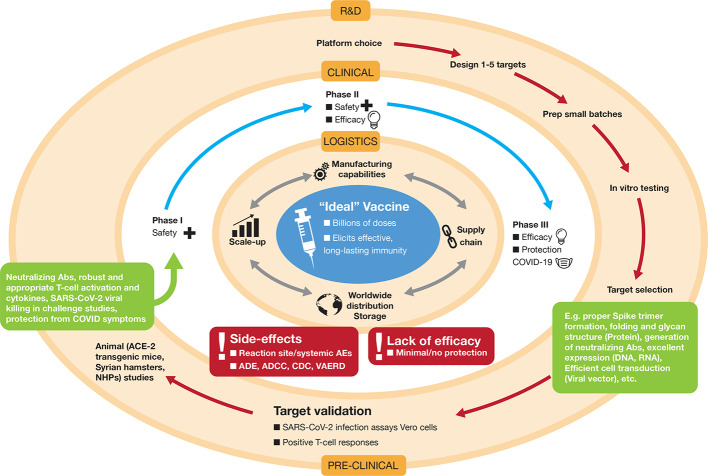Figure 3.
Development of the “ideal” vaccine for COVID-19 depicted by concentric circles converging to the target. Normally, development occurs in three discrete phases: Research and Development (R&D) involving platform selection, designing targets (e.g. whether that might be selection of an RNA sequence and decisions on nucleoside substitutions, lipid nanoparticle (LNP) formulation, etc, or decisions on how to create a live-attenuated viral preparation) and preclinical testing in vitro in cell culture and in vivo in animals. For SARS-CoV-2 R&D, some of the animal models used are transgenic mice that overexpress the Spike-binding protein ACE-2, Syrian hamsters, ferrets, and non-human primates (NHPs). If encouraging results are apparent in the preclinical phase (indicated by various parameters in green boxes), the candidate vaccine is taken to the second phase, which consists of testing in human volunteers in three stages of clinical trials (Phase I, Phase II, and Phase III). These may be concatenated to expedite approval (e.g. Phase II/III). Due to the pandemic nature of COVID-19, both these outer concentric phases are being pursued simultaneously under expedited approvals with potential for emergency use authorizations. If, and only when, vaccine safety and efficacy is achieved in human volunteers, the logistical operations become the major hurdles to ensure worldwide distribution in a coordinated and inter-connected manner (manufacturing, supply chain distribution, storage, etc.). Vaccine candidates that do not achieve satisfactory results in clinical trials, due to various factors shown in the red boxes, will be dropped from further development. ADE, antibody-dependent enhancement; ADCC, antibody-dependent cellular cytotoxicity; CDC, complement-dependent cellular cytotoxicity; VAERD, vaccine-associated enhanced respiratory disease; AE, adverse event.

